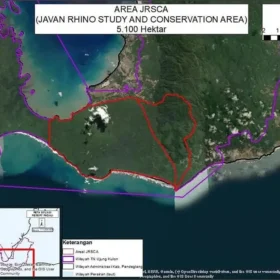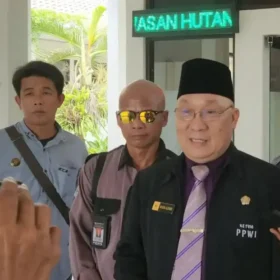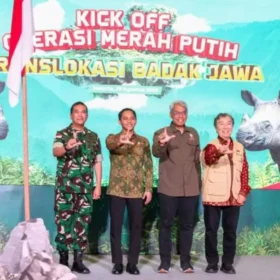Translocation of Javan Rhino Within it’s Natural Habitat. Ujung Kulon National Park Area. The Ujung Kulon National Park Authority (TNUK) has emphasized that the translocation of the Javan Rhino to the Javan Rhino Study and Conservation Area (JRSCA) does not mean relocating this endangered species out of its habitat. The translocation of the Javan Rhinoceros is the process of moving rhino individuals from the Ujung Kulon Peninsula to a location that has been ecologically prepared and deemed safe.
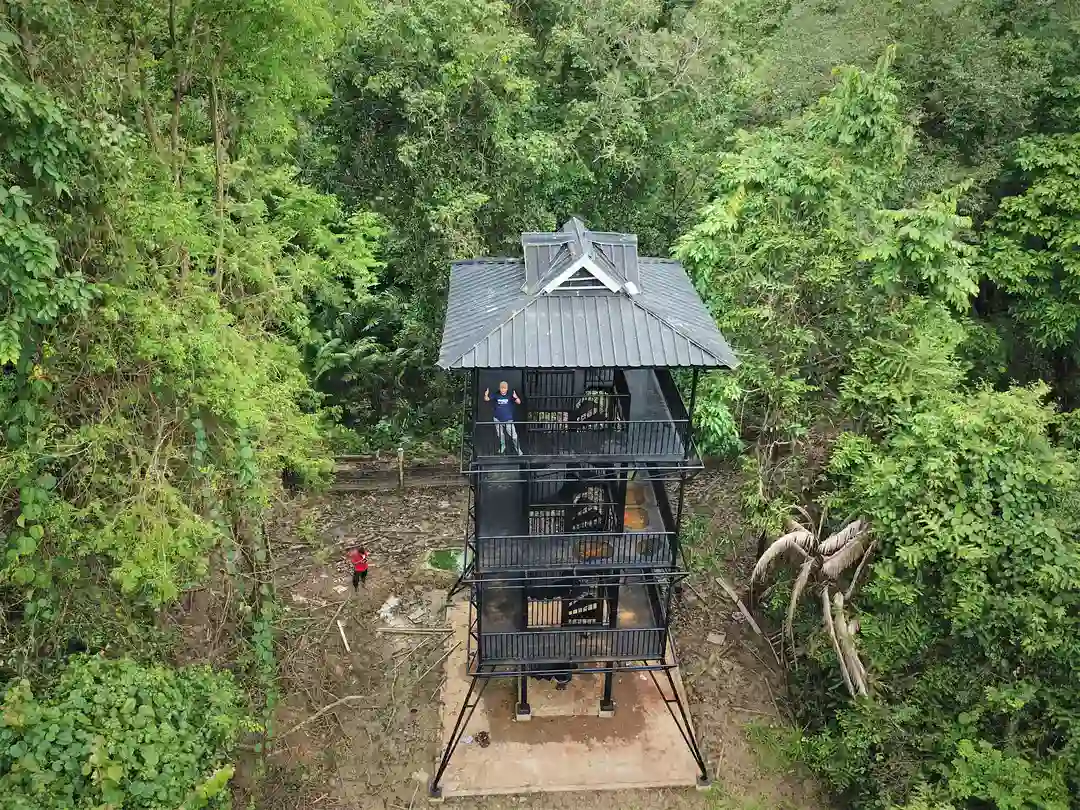
According to the Head of the Ujung Kulon National Park Authority, Ardi Andono, the Merah Putih Operation for the Javan Rhino Translocation is not about moving the rhinos out of the TNUK area. The JRSCA is located within the TNUK area.
As of 2019, six individual rhinos were observed in that area. Therefore, Ardi stated that the JRSCA is not an artificial habitat; it remains the natural habitat of the Javan Rhino, only managed with fencing to make it safer, more closely monitored, and with greater opportunities for breeding.
“So, they remain in their natural habitat. This area is managed to ensure that the rhinos, both male and female, can meet and mate,” he explained.
The JRSCA is the original habitat and part of the TNUK area that has long been inhabited by Javan Rhinoceros. This area serves as a second population area, located not far from the original site and enclosed by fences. The purpose is to support the formation of a new, healthier, and more sustainable population.
The JRSCA, which covers an area of 5,100 hectares, is designed as an effort to increase the population of the Javan Rhino through more measurable conservation strategies. The area is enclosed by fences that were built gradually from 2010, with construction continuing through 2021 to 2022.
With the security fence in place, potential threats from the outside can be minimized, while the chances for natural mating of the rhinos can be enhanced. Inside the JRSCA, there is a 40-hectare paddock, divided into compartments of 10 hectares each, along with a 25-hectare development paddock.
“We want the public to understand that this translocation is a serious conservation strategy, not about imprisoning the rhinos or moving them out of the TNUK area. Instead, it is a real step to protect the rhinos within their natural habitat with better management,” emphasized Ardi.
Through this explanation, the TNUK Authority hopes that the public will support the Javan Rhino Conservation Translocation program, as the success of this program will determine the future of this iconic Indonesian species in its natural habitat.
Source: SIARAN PERS Nomor: SP. 191/HUMAS/PP/HMS.3/9/2025
Translocation within Original Habitat
While many people associate translocation with moving animals to entirely new environments, this is not the case for the Javan Rhino. The Javan Rhino Study and Conservation Area (JRSCA), where the translocation occurs, is located within the boundaries of TNUK and serves as a specialized management zone for the rhinos.
Key Points
Translocation Within the Same Habitat
Translocating the Javan Rhino does not mean removing it from its natural habitat. Instead, it’s about carefully moving individual rhinos to a specific area within TNUK that has been prepared ecologically and is safe for their population. The goal is to provide a controlled environment where the rhinos can thrive and reproduce, contributing to the overall health of the species.
The Javan Rhino Study and Conservation Area
The JRSCA is not an artificial habitat. It is an area within TNUK that has long been inhabited by the Javan Rhino, serving as an important part of their natural environment. The area is surrounded by fences to minimize external threats and facilitate better monitoring. This is designed to increase the chances of natural breeding and ensure a safe, secure space for the rhinos.
The Role of JRSCA in Conservation
JRSCA functions as a secondary population area, specifically set aside to support the creation of a more sustainable and diverse population of Javan Rhinos. With a total area of 5,100 hectares, this area is managed with the goal of increasing the rhino population through a more structured conservation approach. It includes paddocks of varying sizes to give the rhinos enough space while keeping them within a manageable environment that encourages mating and population growth.
Fencing for Protection
The fencing around JRSCA, constructed gradually since 2010, provides a secure perimeter to protect the rhinos from external threats. By 2022, the fencing was completed, allowing for a safer space where the rhinos can interact, mate, and build a stable population. Inside the fenced area, there are several paddocks, with some sections designed for development and breeding.
Conservation Strategy
The translocation program is not about confining or isolating the rhinos; it is a critical part of a long-term conservation strategy. The aim is to create a secure and sustainable environment that keeps the rhinos in their natural habitat while providing better management, monitoring, and breeding opportunities. This will help maintain a healthy population in the long run.
Public Understanding and Support
The authorities at TNUK, including the Head of the National Park, Ardi Andono, emphasize the importance of public understanding and support for the translocation program. It is a carefully planned and serious conservation effort that aims to secure the future of the Javan Rhino, an iconic species for Indonesia.
By supporting these efforts, we ensure that the Javan Rhino can continue to exist in its natural habitat for generations to come, contributing to the preservation of one of the world’s most unique ecosystems.
Previews News about Translocation of Javan Rhino
Translocation of Javan Rhino is planned from the natural habitat in the Ujung Kulon Peninsula to the JRSCA in Ujungjaya Village, Pandeglang Regency. Both locations are still within the Ujung Kulon National Park area and are approximately 14 kilometers apart, crossing the sea.
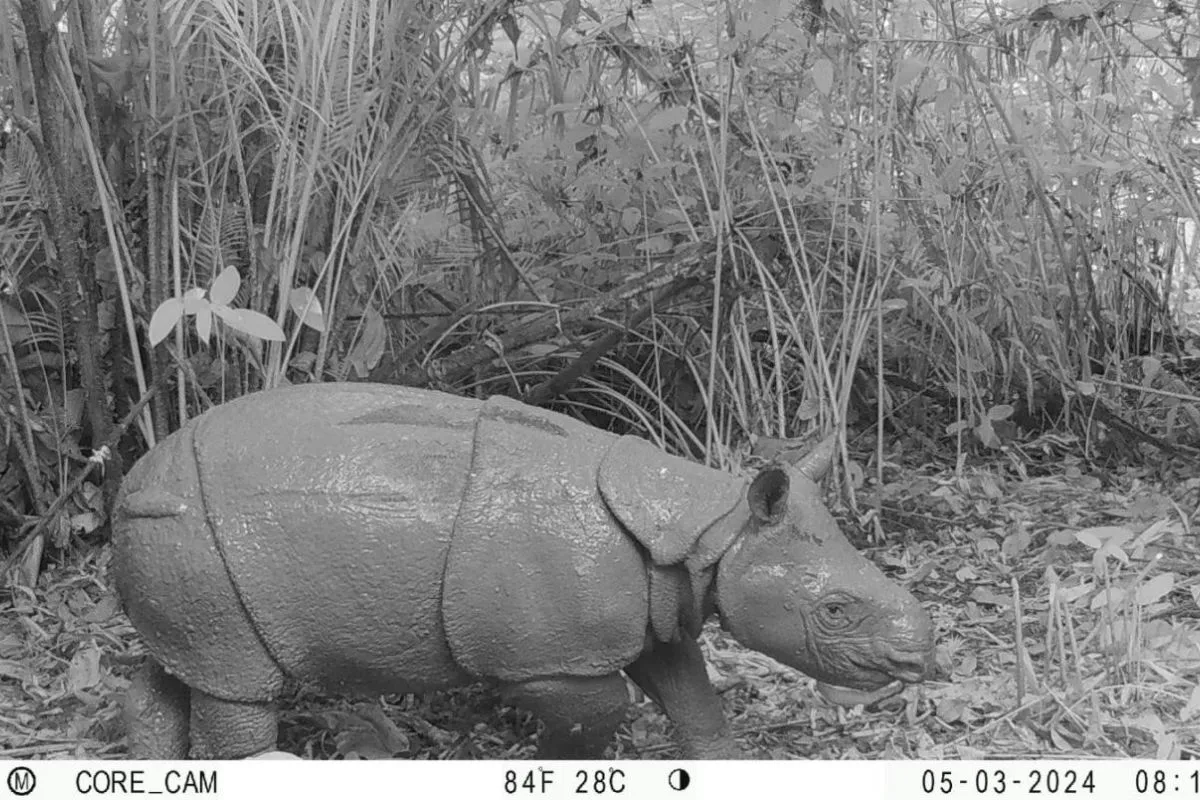
Why Translocation of Javan Rhino
The Ministry of Forestry, through the Directorate General of Natural Resources and Ecosystem Conservation (KSDAE), continues to work on the conservation of the Javan Rhino by planning the translocation of Javan Rhino (selected individuals) to a special conservation area, the Javan Rhino Study and Conservation Area (JRSCA).
Read: The proposed translocation of the Javan rhinoceros
The translocation of Javan Rhino process is carried out with the support of the Indonesian Navy (TNI AL), the Indonesian Rhino Foundation (YABI), and various other conservation partners.
The Director-General of KSDAE, Satyawan Pudyatmoko, explained the need for the translocation of Javan Rhino. One of its purposes is to support a breeding program to help increase the genetic diversity of the rhino population.
“The condition of the Javan Rhino population in the wild shows indications of a decline in genetic variety. Therefore, translocating to the JRSCA can help prevent inbreeding and strengthen the genetic resilience of the Javan Rhino population,” he said.
Amphibious Vehicle
To prepare for this process, the Amphibious Vehicle Battalion of the Marine Corps (Yonkapa) 1 held a simulation of the Kapa K-61 armored amphibious vehicle in Jakarta on Wednesday (28/5), to test the ability to transport the Javan Rhino cage across the sea.
“This simulation is crucial to ensure the translocation of javan rhino process is safe and minimizes risks, considering the long sea crossing distance,” said Satyawan.
He added that the involvement of the Marine Corps in the conservation of rare wildlife also represents a strategic cross-sector collaboration.
Responding to this, the Commander of Yonkapa 1, Major (Mar) Bayhaky C. Chipta, stated that this activity is also part of the TNI AL’s preparedness to support the evacuation of wildlife during natural disasters such as tsunamis, volcanic eruptions, or forest fires. The Kapa K-61 vehicle was tested for its ability to carry transport cages while considering safety, stability, and mobilization efficiency on both land and sea.
The transport cage used in the simulation was specially designed to meet the comfort and safety standards for the animals, equipped with a ventilation system and shock-absorbing supports. The cage weighs around 1 ton, while the simulated weight of the Javan Rhino is 1.6 tons.
The simulation showed that the Kapa K-61 amphibious vehicle is highly suitable for the Javan Rhino translocation, opening new hope for the conservation of this rare species in a safer and more controlled habitat.
Prevent Inbreeding
The Indonesian Ministry of Forestry is planning to translocate several Javan rhinos (Rhinoceros sondaicus) to the Javan Rhino Study and Conservation Area (JRSCA) as part of a breeding program.
In a statement received in Jakarta on Thursday, the ministry’s Director General of Natural Resources and Ecosystem Conservation, Satyawan Pudyatmoko, explained that the Javan Rhino Translocation program aims to genetically diversify the rhino population.
“There are indications of a decline in genetic variety among Javan rhinos in the wild. Therefore, translocation to the JRSCA could help prevent inbreeding and strengthen the genetic resilience of the population,” he remarked.
He affirmed that the Forestry Ministry would implement the conservation plan in partnership with the Indonesian Navy (TNI-AL), the Indonesian Rhinoceros Foundation (YABI), and other partners.
Elaborating further on the plan, Pudyatmoko said that several rhinos would be moved about 14 kilometers from the Ujung Kulon Peninsula —both located within the Ujung Kulon National Park in Banten Province— using tactical TNI-AL vehicles via sea routes.
In preparation, the TNI-AL Marine Corps conducted a simulation on May 28 in Jakarta to test the use of Kapa K-61 amphibious battle vehicles for transporting the Javan rhinos.
“This simulation is crucial to ensure the translocation process runs safely with minimal risks, considering the long distance,” he remarked.
He highlighted the Marine Corps’ involvement in this endangered species conservation project as a strategic example of cross-sector collaboration.
Meanwhile, Commander of the Marine Corps’ Artillery Transport Amphibious Vehicle Battalion (Yonkapa) 1, Major Bayhaky C. Chipta, emphasized that the mission reflects TNI-AL’s preparedness for rescuing wild animals during natural disasters.
He explained that the Kapa K-61 amphibious vehicles were tested with a focus on safety, stability, and efficiency.
The simulation involved a specially designed cage weighing about one ton, equipped with ventilation and shock-absorption buffers to ensure sufficient oxygen supply and minimize jolts.
Chipta affirmed that the simulation showed the amphibious vehicles meet the standards required to safely translocate Javan rhinos, supporting efforts to improve the species’ survival prospects.

